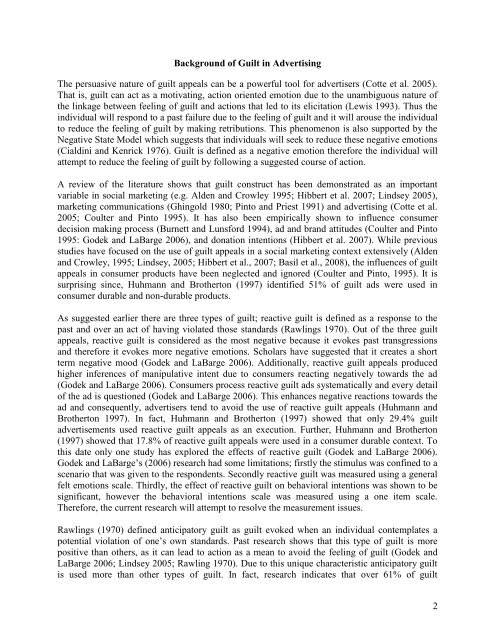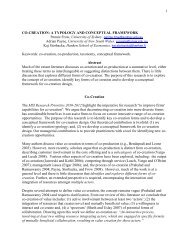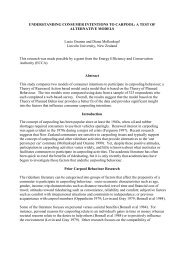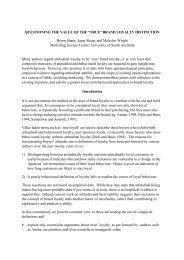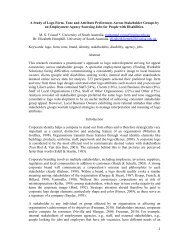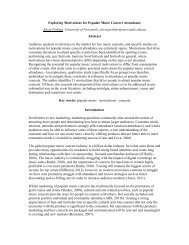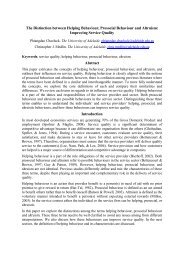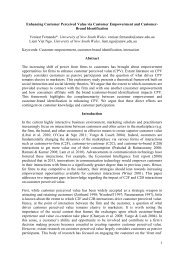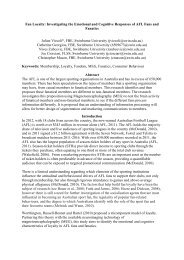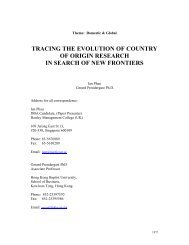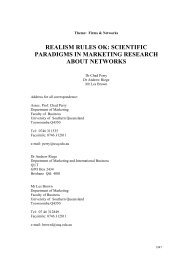1 Exploring a New Measure for Reactive Guilt Appeals ... - ANZMAC
1 Exploring a New Measure for Reactive Guilt Appeals ... - ANZMAC
1 Exploring a New Measure for Reactive Guilt Appeals ... - ANZMAC
Create successful ePaper yourself
Turn your PDF publications into a flip-book with our unique Google optimized e-Paper software.
Background of <strong>Guilt</strong> in Advertising<br />
The persuasive nature of guilt appeals can be a powerful tool <strong>for</strong> advertisers (Cotte et al. 2005).<br />
That is, guilt can act as a motivating, action oriented emotion due to the unambiguous nature of<br />
the linkage between feeling of guilt and actions that led to its elicitation (Lewis 1993). Thus the<br />
individual will respond to a past failure due to the feeling of guilt and it will arouse the individual<br />
to reduce the feeling of guilt by making retributions. This phenomenon is also supported by the<br />
Negative State Model which suggests that individuals will seek to reduce these negative emotions<br />
(Cialdini and Kenrick 1976). <strong>Guilt</strong> is defined as a negative emotion there<strong>for</strong>e the individual will<br />
attempt to reduce the feeling of guilt by following a suggested course of action.<br />
A review of the literature shows that guilt construct has been demonstrated as an important<br />
variable in social marketing (e.g. Alden and Crowley 1995; Hibbert et al. 2007; Lindsey 2005),<br />
marketing communications (Ghingold 1980; Pinto and Priest 1991) and advertising (Cotte et al.<br />
2005; Coulter and Pinto 1995). It has also been empirically shown to influence consumer<br />
decision making process (Burnett and Luns<strong>for</strong>d 1994), ad and brand attitudes (Coulter and Pinto<br />
1995: Godek and LaBarge 2006), and donation intentions (Hibbert et al. 2007). While previous<br />
studies have focused on the use of guilt appeals in a social marketing context extensively (Alden<br />
and Crowley, 1995; Lindsey, 2005; Hibbert et al., 2007; Basil et al., 2008), the influences of guilt<br />
appeals in consumer products have been neglected and ignored (Coulter and Pinto, 1995). It is<br />
surprising since, Huhmann and Brotherton (1997) identified 51% of guilt ads were used in<br />
consumer durable and non-durable products.<br />
As suggested earlier there are three types of guilt; reactive guilt is defined as a response to the<br />
past and over an act of having violated those standards (Rawlings 1970). Out of the three guilt<br />
appeals, reactive guilt is considered as the most negative because it evokes past transgressions<br />
and there<strong>for</strong>e it evokes more negative emotions. Scholars have suggested that it creates a short<br />
term negative mood (Godek and LaBarge 2006). Additionally, reactive guilt appeals produced<br />
higher inferences of manipulative intent due to consumers reacting negatively towards the ad<br />
(Godek and LaBarge 2006). Consumers process reactive guilt ads systematically and every detail<br />
of the ad is questioned (Godek and LaBarge 2006). This enhances negative reactions towards the<br />
ad and consequently, advertisers tend to avoid the use of reactive guilt appeals (Huhmann and<br />
Brotherton 1997). In fact, Huhmann and Brotherton (1997) showed that only 29.4% guilt<br />
advertisements used reactive guilt appeals as an execution. Further, Huhmann and Brotherton<br />
(1997) showed that 17.8% of reactive guilt appeals were used in a consumer durable context. To<br />
this date only one study has explored the effects of reactive guilt (Godek and LaBarge 2006).<br />
Godek and LaBarge’s (2006) research had some limitations; firstly the stimulus was confined to a<br />
scenario that was given to the respondents. Secondly reactive guilt was measured using a general<br />
felt emotions scale. Thirdly, the effect of reactive guilt on behavioral intentions was shown to be<br />
significant, however the behavioral intentions scale was measured using a one item scale.<br />
There<strong>for</strong>e, the current research will attempt to resolve the measurement issues.<br />
Rawlings (1970) defined anticipatory guilt as guilt evoked when an individual contemplates a<br />
potential violation of one’s own standards. Past research shows that this type of guilt is more<br />
positive than others, as it can lead to action as a mean to avoid the feeling of guilt (Godek and<br />
LaBarge 2006; Lindsey 2005; Rawling 1970). Due to this unique characteristic anticipatory guilt<br />
is used more than other types of guilt. In fact, research indicates that over 61% of guilt<br />
2


